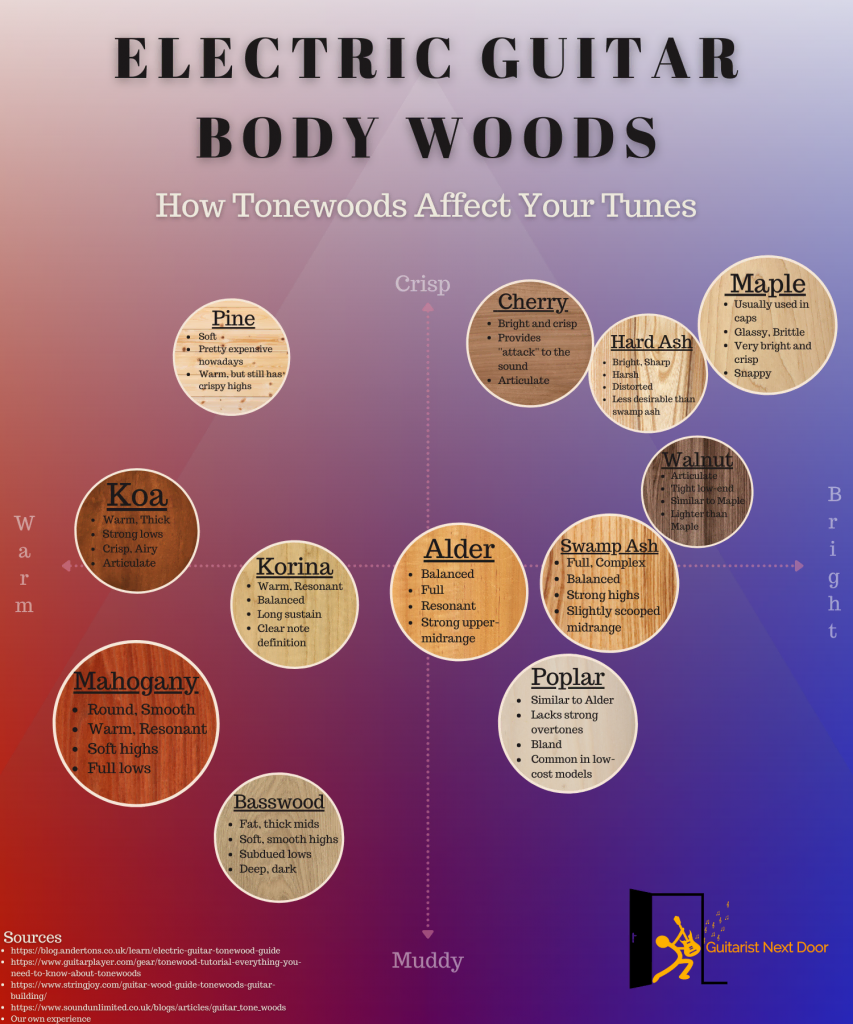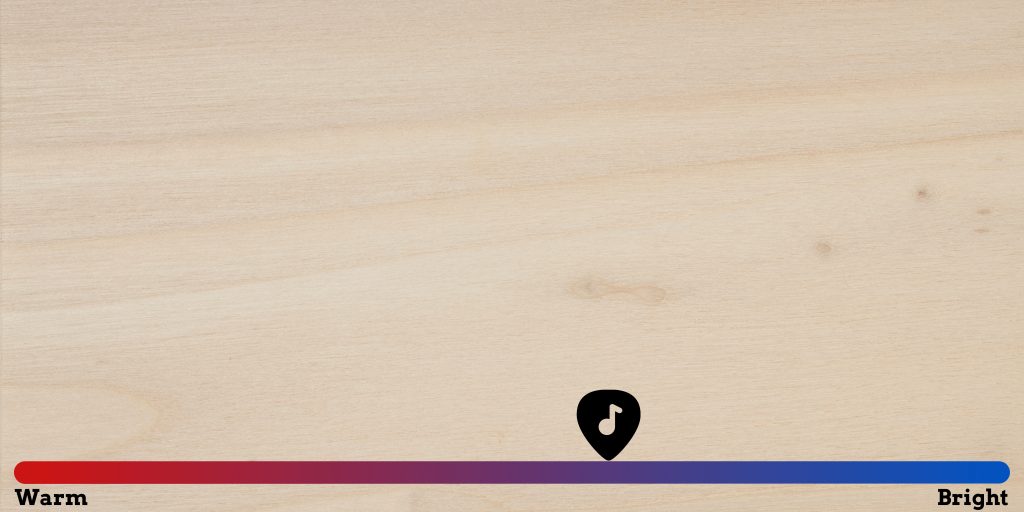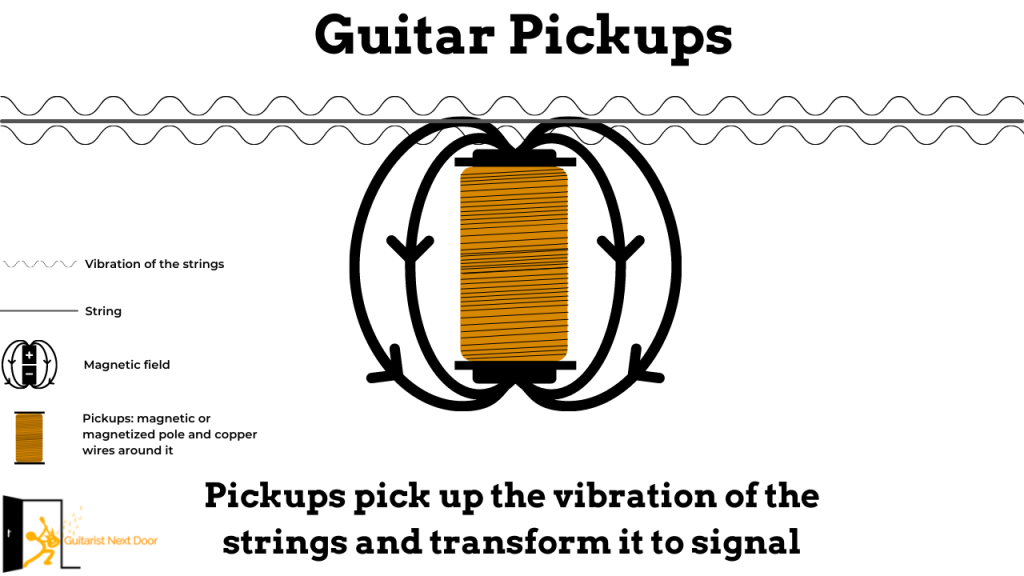Last Updated on March 3, 2024 by Teemu Suomala
We both know this. It’s no secret…
Tonewoods and their impact on the sound of your electric guitar is a much-debated topic, and to this day some swear by the name of tonewoods, and others don’t believe woods make a difference at all.
In this article, you find a cool tonewood graphic, go through the most popular tonewoods, and see how they affect your tone (if they do). After that, I reveal some proof and truths about the tonewood debate, and by the way, you might be surprised…
Let’s get started!
Learn about acoustic guitar tonewoods here.

Author: Teemu Suomala
Note: Based on how electric guitar pickups work and tests we have seen and done, woods of electric guitar have minimal/non-existent impact to the sound when played through amplifier. Strings, pickups, and electronics create the sound and tones. But woods can affect the sound when played unplugged, especially with semi-hollow and hollow body electric guitars.
Different Electric Guitar woods
Electric Guitar Tonewood Chart

The above image highlights how the tonewoods of electric guitars should affect the tone based on wood density, other wood characteristics, and guitar player’s & luthier’s experiences we have gathered. It can direct you in the right direction when choosing the woods for your guitar and it also looks cool!
Electric Guitar Tonewoods Density Chart (denser the wood is, heavier it is):
| Wood | (103 kg/m3) | (lb/ft3) |
|---|---|---|
| Alder | 0.4 – 0.7 | 26 – 42 |
| Basswood | 0.3 – 0.6 | 20 – 37 |
| Cherry | 0.63 | 43- 56 |
| Hard Ash | 0.65 – 0.85 | 40 – 53 |
| Koa | 0.6 | 37 |
| Korina (Limba) | 0.55 | 35 |
| Mahogany | 0.5-0.6 | 31 – 37 |
| Maple | 0.6 – 0.75 | 39 – 47 |
| Pine | 0.42 – 0.67 | 26 – 53 |
| Poplar | 0.35 – 0.5 | 22 – 31 |
| Swamp Ash (Black ash) | 0.54 | 33 |
| Walnut | 0.65 – 0.7 | 40 – 43 |
Let’s now look closer at each wood type!
Other guitar guides worth reading:
Electric Guitar Body Shapes and Styles – Explained
Alder

Density :
| (103 kg/m3) | (lb/ft3) |
|---|---|
| 0.4 – 0.7 | 26 – 42 |
Availability of Alder: Great
Mainly 2 different alder types are used in electric guitars:
With both, the grains are usually straight and workability is easy. Alder species used in electric guitars are usually not very dense and offer a well-balanced tone, resonate freely, and produce good sustain.
Fender has used alder in many of their guitars since 1956, and even to this day, it’s one of the most popular body woods on Fender’s guitars. Brands using alder frequently:
- Fender
- ESP
- Charvel
- Sire Larry Carlton
- Schecter
- Ibanez
Alder is a great option, if you are looking for a tonewood that offers a balanced and well-resonating sound that highlights the bright tones a little bit.


Basswood

Density :
| (103 kg/m3) | (lb/ft3) |
|---|---|
| 0.3 – 0.6 | 20 – 37 |
Availability of Basswood: Great
Basswood has mainly straight grains and is a very light and soft wood. Because of these qualities, it’s very easy to work with and a really popular wood, especially with budget guitars. Basswood produces a very full(fat) and deep sound and can smoothen the bright tones.
Basswood has a reputation of cheap electric guitar body wood, but it’s used in many higher-priced instruments too, such as EVH and Music Man guitars. Brands that use Basswood frequently:
- Squier
- ESP
- EVH
- Music Man
- Fender
- Ibanez
- Jackson
- Godin
Basswood is a great option if you want full and balanced tone that offers great low-end and smoothens bright tones a bit. Basswood is known for being a great fit with humbuckers.

Cherry

Density :
| (103 kg/m3) | (lb/ft3) |
|---|---|
| 0.63 | 43- 56 |
Availability of Cherry: Great
Cherry is relatively light wood and its grains are usually straight but can have light waves. It’s easy to work with wood and provides a crisp, bright, and articulate tone.
Cherry is rarely used with solid-body electric guitars, but it’s found in some hollow-body electric guitars. Brands that frequently use Cherry:
- Godin
Cherry is a good option if you want similar tonal qualities to maple but are after something a bit more articulate.

Hard Ash (Northern ash, White ash)

Density :
| (103 kg/m3) | (lb/ft3) |
|---|---|
| 0.65 – 0.85 | 40 – 53 |
Availability of Hard Ash: Great
Grains in hard ash are usually straight, although some waves can be present. Hard ash is denser than swamp/black ash and provides some similar tonal qualities to maple. The sound it provides is bright, sharp, and sometimes even harsh.
Ash can be difficult to work with since its open pores must be filled before applying the finish.
Fender has been using different kinds of ash wood with their guitar since the early 1950s. Brands that use Hard Ash frequently:
- Fender
- Ibanez
- Schecter
- Jackson
- ESP
- D’Angelico
Hard ash can be a great option if you are after bright, sharp, and harsh sound.

Koa

Density :
| (103 kg/m3) | (lb/ft3) |
|---|---|
| 0.6 | 37 |
Availability of Koa: Limited
Grains of koa are usually really close to each other and wavy. Koa is usually easy to work with, but if grains are heavily interlocked some problems can arise. Koa is lightweight and softer than most pieces of ash, maple, and alder. The sound koa produces is really full and articulate, with warm tones and strong lows.
These brands use koa in their electric guitars frequently:
- Godin
- ESP
- Fender
- Epiphone (not frequently)
Koa is a great option if you want stunning “wood”-looks, full and articulate sound, and both warmness and brightness.

Korina (Limba)

Density :
| (103 kg/m3) | (lb/ft3) |
|---|---|
| 0.55 | 35 |
Availability of Korina: Good
Grains are straight but can be interlocked and the workability of Korina is usually great. Korina is a soft wood and produces many similar tonal characteristics to mahogany. Korina offers a really clear note definition and long sustain. The sound is balanced and resonant.
Korina is usually used in electric guitars costing over $1k. Reverend guitars is one of the manufacturers that use Korina in many of their electric guitars. Brands that use Korina frequently:
- Reverend
- Gibson
- Schecter
Korina is a great wood option if you want soft wood that is articulate and offers warmth but doesn’t lack brightness either.

Mahogany

Density :
| (103 kg/m3) | (lb/ft3) |
|---|---|
| 0.5-0.6 | 31 – 37 |
Availability of Mahogany: OK
Grains of mahogany are straight and can be interlocked. Mahogany is usually very easy to work with, but interlocking of the grains can cause issues. The mahogany used in guitars is usually a soft wood that provides warm, deep, and round sounds with smooth highs.
Different types of mahogany used in electric guitars:
- African mahogany
- Central-American mahogany (Honduran & Cuban)
Mahogany is one of the most popular electric guitar body woods. Brands that use mahogany in their electric guitars frequently:
- Gibson & Epiphone
- Fender
- PRS
- ESP
- Yamaha
- Schecter
- Jackson
- Gretsch
Mahogany is a great wood option if you are after soft wood that offers round, warm, and full sound.

Okoume – Cheaper Alternative to Mahogany
Okoume is a soft hardwood with straight grains and is used in electric guitars from many different price ranges. It provides really similar sound to mahogany. Brands using okoume frequently:
- Ibanez
- Music Man
- Washburn
- Epiphone
Maple

Density :
| (103 kg/m3) | (lb/ft3) |
|---|---|
| 0.6 – 0.75 | 39 – 47 |
Availability of Maple: Great
Grains of maple are usually straight but can have waves. Usually easy to work with, hard maple being more difficult than soft maple species. Maple is a dense wood that provides bright, crisp, and even glassy sound.
Different types of maple used in electric guitars:
- Silver maple
- Soft maple
- Hard maple
- Quilted maple(anomaly that can happen for different maple species, most common with soft maple)
Maple is used in many electric guitars due to its great availability. Brands that use maple in their electric guitars frequently:
- Fender
- ESP
- Godin
- Yamaha
Maple is a great wood option if you are after bright, crisp, and glassy sound.

Pine

Density :
| (103 kg/m3) | (lb/ft3) |
|---|---|
| 0.42 – 0.67 | 26 – 53 |
Availability of Pine: Great
Pine has straight grains and is usually easy to work with. There are lots of different pine species, so there might be exceptions too. Density between different pine species varies, but it’s considered to be relatively soft hardwood in general. Pine produces a warm tone with crispy highs.
Different species of pine are really common, but when it comes to electric guitars, it’s not one of the most popular woods. Brands that use pine in their electric guitars frequently:
- Fender & Squier
- G&L
Pine is an excellent wood type if you are after soft wood that produces a warm tone with crispy highs.

Poplar

Density :
| (103 kg/m3) | (lb/ft3) |
|---|---|
| 0.35 – 0.5 | 22 – 31 |
Availability of Poplar: Great
Straight grains, easy to work with, and fairly soft. Poplar offers similar tonal qualities to alder but is muddier and not so articulate. Usually used in cheaper electric guitars, but can be found from more expensive ones too.
Brands that use poplar frequently:
- PRS
- Ibanez
- Squier
- Jackson
If you are after an affordable and soft hardwood that produces balanced, but not very articulate tones with not the best sustain, poplar is a great option.

Swamp Ash (Black ash)

Density :
| (103 kg/m3) | (lb/ft3) |
|---|---|
| 0.54 | 33 |
Availability of Swamp Ash: Limited
According to wood-database.com, “the term “Swamp Ash” is used loosely to describe pieces of ash that have low densities and good acoustic properties”
Grains of swamp ash are straight most of the time and it’s easy to work with wood. It’s softer than hard maple and produces fuller tones, but doesn’t lose much brightness.
Several electric guitars still have swamp ash bodies. Brands that use swamp ash frequently:
- Schecter
- ESP
- Sire Marcus Miller
- Godin
- G&L
Swamp ash is a great option if you are looking for soft hardwood that provides full sound with crispness and brightness in it.

Walnut

Density :
| (103 kg/m3) | (lb/ft3) |
|---|---|
| 0.65 – 0.7 | 40 – 43 |
Grains of walnut are straight, but there can be irregular patterns. Usually easy to work with, but irregular patterns of grains can sometimes cause tearing. Walnut provides some similar tonal characteristics to ash species. The sound is articulate, smooth, and bright with a tight low-end.
Walnut species usually used in electric guitars are:
Walnut can usually be found from more expensive electric guitars. Brands that use walnut frequently:
- Gibson
- PRS
Walnut is a great wood if you are after some ash-like qualities, overall bright and smooth sound with a tight low-end, and good articulation.

Which is the Best Wood for Electric Guitar?
There’s no “best” wood for electric guitar out there for everyone. If you craft guitars, you might start to prefer some wood because of its looks and how easy its to work with. People who believe that tonewoods affect the sound of the electric guitar can go through our in-depth article and choose which wood fits their taste. Also, if you are after specific weight or looks, this guide can be extremely helpful. I personally like the looks of quilted maple, walnut, and koa the most(especially the koa, it’s stunning).
FAQ
You know what? I want to always cheer people up. Empower them. If something in your life feels extremely hard right now…the thing is…you can make it. Just take the first small step. Then another. And then another. You got this my friend.
Teemu – Founder of GND
Do Tonewoods Matter on Electric Guitar?
Humans are not able to notice tonewood’s impact on the sound of electric guitar. So basically no, tonewoods don’t matter on electric guitars. Why we can say so? Let’s look at how electric guitar pickups work and then I will share a video that reveals something really interesting.

In a nutshell: pickups pick up the vibration of the strings directly from the strings and transform it to a signal. Resonation of the woods have a minimal/non-existent impact on this vibration.
So, the strings, pickups, and other electronics are the main parts that create the sound of the electric guitar.
But why there’s so much hype about tonewoods? Mainly because of 2 reasons:
- There’s a misconception that woods affect the sound of electric guitar and here placebo kicks in. We hear what we think we should hear.
- Guitar brands either don’t know that wood doesn’t matter the sound of the electric guitar or they just want to maintain the “tonewoods”-image because it most likely supports their marketing and sales.
And if you don’t believe that woods don’t impact the sound of electric guitar, I want to share one of the most eye-opening tests done about guitar tonewoods. Check this piece out:
So understanding how pickups work and backing up this with great video resources like the one above, convinced me. Woods of electric guitar doesn’t affect the sound.
But do woods matter at all?
Well, they affect the looks, weight, feel, and longevity of the guitar, so yes, woods have an impact on your overall guitar experience. They just don’t affect the plugged-in tone of the electric guitar.
But especially if you are planning to play hollow body electric guitar unplugged, then the body woods will affect the sound, since the sound waves bounce inside the sound chamber and produce a sound. And here especially the density of the wood affects the sound.
Find Amazing Hollowbody Guitars Here.
Personally, I will pay attention to the woods of electric guitars. Neck and fretboard woods have a big impact on the feel of the instrument, and body woods impact the weight and looks of the electric guitar a lot.
What Kind of Wood Are Electric Guitars Made From?
Here I gathered most of the woods used in electric guitars.
Fretboard Woods
- Rosewood
- Maple
- Ebony
- Laurel
- Pau Ferro
- Jatoba
- Amaranth
- Walnut
- Purpleheart
- Richlite
- Ovangol
- Panga Panga
- Cherry
Rosewood vs Maple fretboard? Which is better for you?
Neck Woods
- Maple
- Mahogany
- Walnut
- Wenge
- Padauk
- Korina (limba)
- Bubinga
- Nato
- Okoume
- Purpleheart
- Rosewood
- Pau Ferro
- Panga Panga
Body Woods
- Mahogany
- Alder
- Poplar
- Okoume
- Ash (swamp & hard)
- Walnut
- Nyatoh
- Basswood
- Meranti
- Nato
- Sassafras
- Pine
- Korina (limba)
- Agathis
Top Woods
- Maple
- Poplar
- Burl (Burl is usually a rounded outgrowth from the tree(deformed))
- Ash
- Ziricote
- Walnut
- Cherry
- Mahogany
- Spruce
Does Guitar Neck or Fretboard Wood Affect Tone?
No. Pickups pick up the vibration of the strings directly from the strings. Neck and fretboard wood have minimal impact on the vibration of the strings, so their impact on the tone is minimal/non-existent too. Neck and fretboard woods are important because they have a huge impact on the looks, feel, and weight of the instrument.
Does Bridge, Saddle, or Nut Affect The Tone?
It’s far more likely that these key parts of electric guitars have an impact on the sound. Why? Because especially saddles and nuts are in direct contact with the strings and can affect how the strings vibrate. So most likely saddles and nut have a small impact on your electric guitar’s sound.
The bridge’s impact on the sound is another thing. Saddles are usually part of the bridge, so basically yes, the bridge is in direct contact with the strings. And with some bridges(wrap-arounds for example), strings are anchored to the bridge, and this can have a tiny impact on the string vibration.
Conclusion
Tonewoods are a really interesting topic and I mainly like to geek about them because of the feel, weight, and looks they give to the electric guitar. I created this guide to provide info about those things and also to serve people who do think that tonewoods affect the sound of electric guitar, and to reveal how tonewoods affect the sound when played unplugged.
If you have any questions, experiences to share, or you spotted a mistake, just comment down below and let’s chat. I wish you all the best and keep rocking!
Teemu





There’s more info about tonewoods, body shape and pickups in this guide I’ve found:
https://www.youtube.com/watch?v=HgRfBvqTlPg
Thanks for pointing that out George!
I tend to believe people like John Suhr ,Tom Anderson and George Lynch and others who say tonewoods have a major impact on the sounds of a guitar . Pickups to a much lesser extent .
Thanks for commenting and visiting my website! It’s really likely that they have said something like that. But what I have seen and based on my research pickups are the thing that matter the most. Tonewoods are mostly only advertised as “game-changers”. You can watch this great video: https://www.youtube.com/watch?v=n02tImce3AE&t=522s
It is true that the wood of a guitar doesn’t impact the plugged in tone. However, it does affect the acoustic properties, especially the literal feel of the guitar as vibrations move through it. I tried a “silent” guitar(basically just a metal frame with strings and pickups), and it felt absolutely horrible to play. You probably wrapped all this into “playability” but I just wanted to put it out explicitly.
Otherwise, great article. Really helped me understand what to look for for a custom guitar I’m having made.
True. I only mentioned that woods do matter the feel and playability. I didn’t tackle those since so many things affect the feel and playability, so it’s really hard to say what exactly was the specific woods affect on the playability. But again, your point is very true and I might add a little section about that stuff to this article, so thanks for pointing that out man. And awesome if the article helped you out! Hopefully you absolutely love your new custom guitar and thanks for commenting!
The tonewood debate is an interesting one. To me opinions like the one stated here are most surprising, since my personal experience is very different and more in line with the statements of professional luthiers like Tom Anderson.
I’ve played many different guitars and tested the same pickups in different guitars. To my ears there is usually a sound that comes with the guitar and the pickup will change it but only to a small degree.
When people argue that pickups only pick up the strings vibration I agree, but what about those vibrations? They are a mix of everything the string is attached to and especially when pickups are directly mounted to the body wood I would expect them to slightly vibrate themselves.
For instance I also believe that ebony fretboards contribute to the sound in a certain way, creating a very sharp attack. And yes, it is very noticable in the plugged tone.
I would challenge anyone to take a Gibson SG and an ash strat with an ebony fretboard, swap all electronics and mechanics for the exact same parts and put in a pair of the same pickups. The ash strat will probabably sound a lot brighter and snappier.
Thanks for revealing your opinion Nils! Did you watch this: https://youtu.be/n02tImce3AE?t=522
That’s what I believe.